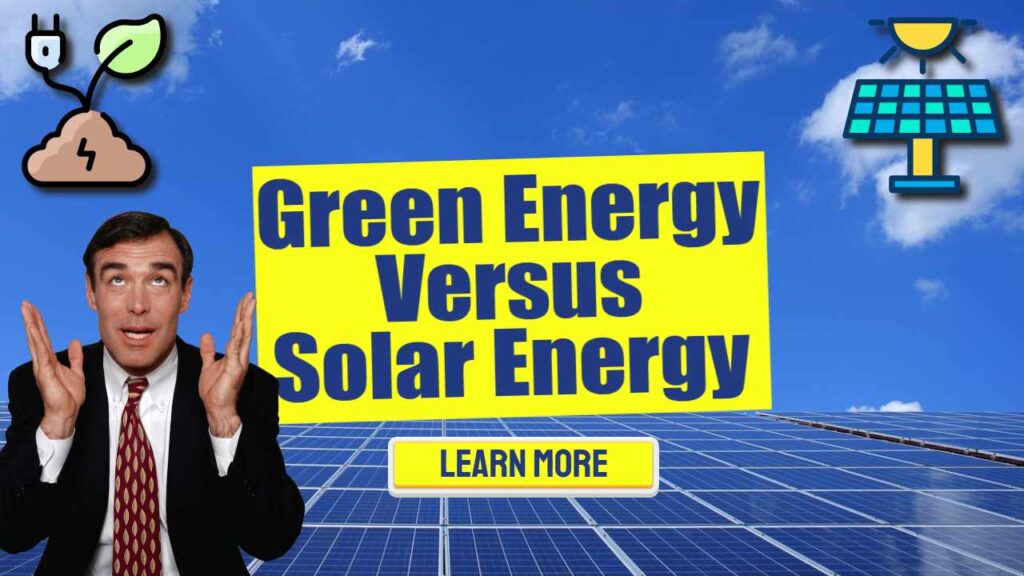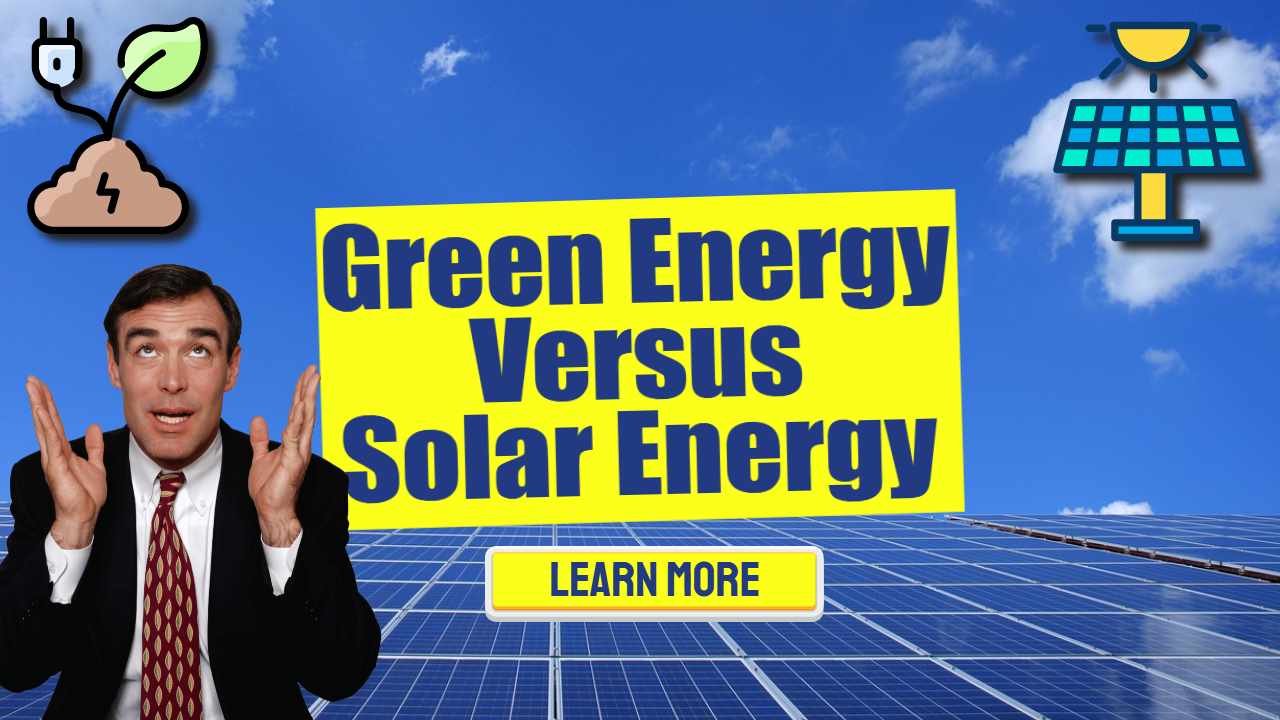Some people wish to compare green energy versus solar energy which is difficult to reply to without first correcting a possible misconception. The misconception is that green energy is essentially not the same as solar energy. However, the fact is that solar energy is just one of the sustainable “green” energy sources, by which we mean renewable energy.
Now we will answer the question of green energy versus solar energy by explaining what green energy is, and what solar energy is, before comparing the main types of green energy with the type of green energy known popularly as solar energy, namely solar panel derived energy (photovoltaic energy or PV).
What are the Main Green Energy Sources?
Green energy is a form of energy that is generated from renewable resources, such as geothermal heat, sunlight, rain and waves. It is clean, environmentally friendly, and is a great way to help the planet. But what is it, and how can we benefit from it?
Let us take a brief look at each, their distinctions and similarities, and how each contributes to the transformation of energy as we know it.
Biowaste Energy
The term “green energy” is often used interchangeably with “green” electricity. This is often produced from the anaerobic digestion of biowaste. Biowaste takes the form of anything from manure to food waste, it also encompasses crop waste such as straw and rice husks.
The range of biowastes available is very wide and largely unexploited, so there is plenty of potential to make more biogas. The raw biogas is further cleaned and called biomethane. As explained here: https://blog.anaerobic-digestion.com/biomethane-plant-advantages/ biomethane is used as a fuel to replace natural gas (a fossil fuel) and can fuel conventional reciprocation engines including cars, trucks and buses when their engines are specially converted and tuned.
Here are a few examples of green energy sources:
Geothermal
Geothermal energy is energy that is stored deep inside the earth. It has long been used for bathing and has the potential to produce 10 times more electricity than coal. Although geothermal energy requires drilling, this natural resource can yield more than enough energy to run a turbine. In addition to being green, geothermal energy is a huge resource when it is harnessed.
Hydropower
Hydropower is the creation of power from naturally occurring water sources, such as hydropower dams, and river and tidal barriers. It can be produced on a large scale and is considered to be green energy.
Wind Power
Wind turbines and windmills both deliver wind power as a green energy source and can also be used to power from a single dwelling or mill to a whole neighbourhood or town.
Wind power is certainly green. But it isn’t available to all people. Unlike light which is available everywhere, many places are not very windy. Turbines need wind to operate. But when combined, these two sources can provide plenty of energy to a city.
Technically, wind energy is a kind of solar energy. When the sun’s rays heat the uneven surface of the Earth, hot air rises and cold air sinks. The wind provides a kinetic (motion-based) kind of energy created by this variation in air pressure.
Energy from Municipal Solid Waste (EfW)
It is also possible to harvest the heat from household and commercial waste materials and burn them to generate electricity. This is done inside huge buildings in many cities. These are known as ERFs (Energy Recycling Facilities) which until recently were probably just known as Council Incinerators.
Biomass Energy
This is energy from burning wood and charcoal. it discharges carbon dioxide just like any energy recovery method, but scientists do not count the CO2 from this source when calculating carbon emissions as a greenhouse gas source. That’s because the carbon dioxide from burning wood is assumed to be removed quite soon when the forest or woodland regrows and the tree growth is replenished.
Geothermal
While geothermal is particularly effective in places where it is easy to tap, wind and biomass are ideal for other locations. Depending on your location, wind and solar may be more suited for your specific needs. Ultimately, green energy has the potential to replace fossil fuels in the future. Its versatility and low cost make it an attractive choice for many industries.
Solar energy and geothermal energy are, literally, worlds different. They do, however, have more commonalities than distinctions. After all, these are two of the greenest renewable energy sources available today.
Geothermal energy starts deep below the ground and is manifested as thermal energy or heat.
The Benefits of Green Energy
There are many benefits to green energy, including lower prices and more energy. The first is a reduction in pollution. The latter can be produced on a small scale at home and is the most efficient option for powering a home.
On a larger scale, solar power can be used in large solar panel arrays. The latter is more efficient for supplying towns and industry. It can be used for lighting, cooking, and even in a household for heating.
Hydropower can be used for power generation. It is most commonly used to produce electricity in rural areas. It is best suited for higher altitudes.
Another type of renewable energy is wind. It is a renewable source of energy that is a good fit for offshore sites. However, it requires a large amount of maintenance.
Using Solar Energy to Heat Water and Power Your Home
There are a number of technologies that utilize solar energy, but one of the most popular is using it to heat water or power your home.
The sun is a large source of solar energy, so harnessing it is not difficult. Installing solar panels can be the fastest and most cost-effective way to start using green energy in your home. Whether you’re looking to heat water or power a home, solar technology is an excellent option. Let’s look at some of the possibilities.
Solar Panels (Photovoltaics)
These materials are called “photovoltaics”. They are also referred to as photovoltaic modules when joined together to form a “solar array”.
This technology uses the energy from the sun to power a steam turbine. This steam generates electricity. Thousands of photovoltaic cells can power large buildings and even towns.
In some cases, solar panels can the main source of electricity for an entire city when paired with battery storage for overnight power. These technologies have become much cheaper to install recently, and have very low running costs. Since the covid pandemic, when all fossil fuel costs rose, solar energy (electricity), competes with or is actually cheaper than, conventional (fossil fuel) power plants.
In some countries, such as India which have to import much of their fossil fuel oil, and gas solar is routinely the cheaper option.
Passive Solar Technologies
You can also use absorbent materials to harness solar energy. These materials absorb sunlight in the daytime and release heat when it gets cooler at night. The best systems incorporate lenses and other technologies to maximize the use of the sun’s light. Solar panels provide passive solar energy, and these “photovoltaics” can also be installed on rooftops.
Active Solar Technologies
Using active solar technologies for generating electricity is a viable alternative to fossil fuels. It doesn’t generate emissions while in use, and the energy produced is free of cost once the capital spend to build the solar installation has been repaid. These renewables do not produce greenhouse gases, and can even save money.
Some Fossil Fuel Problems
The main problem with fossil fuels is that they produce greenhouse gases. In contrast, renewable sources of energy are clean and do not pollute the environment. Aside from producing electricity, these power sources also reduce the carbon footprint of cities and the planet.
Besides providing heat and electricity, solar power also offers other benefits. By using solar panels, you can generate power from the sun without any physical fuel to buy. The energy generated by solar energy can also be used very effectively to create light for indoor lighting when a battery is used.
Recent studies have shown that owning a solar energy system will increase your home’s value, boosting your property’s resale price. If you install a solar panel and stay in your house the energy generated from a solar panel can be used for lighting, cooling, and other household needs.
Using photovoltaic cells the sun’s energy is transformed into electricity through the materials of the photovoltaic cells. This type of technology can be placed on buildings and fields. While it is inexpensive and quick and simple to do the benefits of solar power are numerous.
Other Forms of Green Energy Versus Solar Energy
Solar energy is abundant and sustainable because it satisfies current requirements without jeopardising future ones. We cannot possibly utilise too much solar energy. The sun gives us more than enough radiant or solar energy to more than 10,000 times the planet’s total energy consumption.
Solar energy, being a renewable source of energy, is significantly more ecologically benign than traditional forms of non-renewable energy, notably coal which accounts for over 40% of all greenhouse gas production. Unlike coal-fired electricity, solar energy does not contribute to climate change by emitting carbon dioxide.
Wind and solar energy are the renewable energy industry’s heavyweights. They offer electricity to the world’s densest populations and most remote locations. The other forms of renewable energy are also worthwhile and needed if the COP26 2021 Climate Change Conference targets for avoiding runaway climate change, are to be met.
Concluding our Article About Green Energy Versus Solar Energy – Which is Best?
We’re banking on the world’s two largest producers of green energy to help us break our reliance on fossil fuels. However, can they both compete with the non-renewable energy industry’s titans, or is one area a more attractive investment?
All green energy sources have their own significant advantages and disadvantages. However, with either method, a significant advantage is that you are no longer subject to rising natural gas supply costs or to fossil-fuelled electricity price rises.
Solving the energy issue is a critical task for the twenty-first century. Perfect answers will be difficult to find, not only because of the vast disparities in political and popular support for sustainable energy around the globe. But also because of the substantial knowledge necessary to meet the numerous issues inherent in the global energy environment.








It’s fascinating to delve into the nuances of green energy and solar energy! I appreciate your effort to clarify the distinction between the two. For many, the blanket term “green energy” often overshadows the variety of sustainable sources we have at our disposal.
It really is interesting how the term “green energy” can sometimes blend together such a diverse range of sources. While solar energy often takes center stage in discussions, especially with the rise of solar panels in residential areas, there are so many other interesting options out there, like wind, hydro, and even geothermal energy. Each has its own unique benefits and challenges.
You bring up a really good point about how “green energy” encompasses such a wide variety of sources. It’s fascinating to see how each type plays a unique role in the overall energy landscape. I’ve often felt that solar gets a lot of the spotlight, especially with how accessible it’s becoming for homeowners. But, like you mentioned, wind and hydro have their own compelling stories.
Speaking of diverse energy sources, I recently came across some insightful information about biomethane as a sustainable fuel for HGVs that really deepens the conversation around green energy options.
‘Biomethane Questions and Answers – Sustainable Fuel for HGVs’
https://stop-global-warming.co.uk/biomethane-questions-and-answers-sustainable-fuel-for-hgvs/.
You make a great observation about how solar energy tends to dominate the conversation around renewables. It’s interesting how visibility can influence perceptions of efficacy and importance. Wind and hydro definitely have strong merits that deserve more attention, particularly since they can often provide more consistent energy than solar in varying conditions.
You’re spot on with your thoughts about visibility shaping conversations around energy sources. Solar panels are everywhere these days, which gives them a kind of celebrity status in the renewable world. But when you dig a little deeper, it’s clear that wind and hydro have their own compelling stories.
You’ve touched on a fascinating point about the varied landscape of green energy. It’s true that solar often gets the spotlight, especially as more homeowners opt for solar panels, transforming their roofs into mini power plants. But when you peel back the layers, this sector is rich with options that each tell their own story, filled with potential and personal connection.
You’re absolutely right about how solar energy often takes center stage in conversations about green energy. It’s remarkable how solar panels have become a common sight, with homeowners embracing the chance to produce their own energy. But as you mentioned, there’s so much more beneath the surface.
You’ve brought up an important point about the visibility of solar energy in our conversations about green solutions. It’s true; there’s a certain excitement in seeing those panels on rooftops, symbolizing a shift toward self-sufficiency and sustainability. But as you noted, there’s a larger narrative to explore.
You’ve touched on something really important about the way we discuss green energy. Solar panels certainly have made a name for themselves, and it’s impressive to see how they’ve become a part of everyday life for so many folks. But you’re right; there is a lot more complexity to the story.
You’ve brought up a really important point. It’s true that solar panels dominate the conversation around renewable energy, and for good reason. Homeowners are not only able to take control of their energy bills but also contribute to a broader shift towards more sustainable living. However, as you indicated, there’s a whole ecosystem of renewable energy solutions out there just waiting to be explored.
You’ve highlighted a crucial aspect of the renewable energy discussion. While solar panels often take center stage because of their visibility on rooftops and the direct benefits they provide to homeowners, it’s essential to look at the broader landscape of renewable solutions available.
You raise a valid point about the diversity within the term “green energy.” It’s fascinating how some sources, like solar, tend to dominate the conversation, often overshadowing the unique advantages that wind, hydro, and geothermal energy bring to the table.
You bring up a great point about the diversity within “green energy.” It’s fascinating how solar often takes the spotlight, yet there’s such a rich variety of sources that can contribute to a sustainable future. I think about wind energy, for example. It’s not just about big turbines on the horizon; there’s so much innovation happening with smaller, community-scale wind projects that could empower local areas, especially where resources are limited.
It’s great to see how the conversation around green energy is evolving. You’re right; the term can cover such a broad spectrum, often making it easy to overlook the distinct advantages of each source, like solar. One aspect that fascinates me is how solar energy adoption varies by region. In places with abundant sunlight, the potential is remarkable, but in others, it might be about maximizing wind or hydro resources.
You bring up an interesting point about the regional variations in solar energy adoption. It’s pretty striking how geographic factors can determine which green energy solutions make the most sense. In sunny areas like the Southwest, it feels almost like a no-brainer to harness solar power, while in places with more cloud cover, it’s not quite as straightforward.
I really appreciate how you framed the discussion around regional variations in solar energy adoption. It’s definitely true that geography plays a huge role in energy strategies. In places like the Southwest, where sunlight is abundant, tapping into solar energy seems like an obvious choice. However, I’ve often wondered how communities in less sunny areas could still leverage renewable energy resources effectively.
You touched on a key point about energy solutions, and it’s interesting to see how biomethane can provide sustainable fueling options for HGVs, especially in regions where solar might not be as viable.
‘Biomethane Questions and Answers – Sustainable Fuel for HGVs’
https://stop-global-warming.co.uk/biomethane-questions-and-answers-sustainable-fuel-for-hgvs/.
You bring up a really important point about regions with less sunlight. It can be easy to focus on the obvious benefits of solar in sunny locales when discussing renewable energy, but every area has its own strengths and resources that can be strategically developed.
You’re so right about that. It’s interesting how regional strengths vary, and I think there’s a lot of potential in harnessing resources that are readily available in less sunny areas. For instance, some regions might find wind energy to be a more viable option. Places like the Midwest have really leaned into that, and it’s impressive to see how communities have embraced it.
You know, your point about different regions makes me think about how diverse our renewable energy options are beyond just solar; there’s a thoughtful discussion that dives into this very topic.
‘Green Energy Versus Solar Energy – Which One Wins?’
https://stop-global-warming.co.uk/green-energy-versus-solar-energy-which-one-wins/.
It’s fascinating, isn’t it? The way some regions seriously own their energy game. Wind energy isn’t just a “nice idea” for places like the Midwest—it’s practically a badge of honor. You can almost picture those wind turbines flexing their muscles against the open sky.
It’s great to see your enthusiasm for regional strengths in renewable energy! You’re spot on about how different areas can tap into different resources. Wind energy is a powerhouse, especially in places like the Midwest where the conditions are just right. It’s fascinating how communities have really come together to support wind farms and energy initiatives. Those towering turbines have become symbols of local commitment to sustainability.
You really hit the nail on the head with that insight. I often think about how easy it is to fall into the trap of assuming renewable energy solutions are one-size-fits-all. Areas with less sunlight do have their unique challenges, but they also have incredible opportunities in other areas like wind, hydro, or even geothermal energy.
You really bring up an important perspective about renewable energy. It’s so true that the geography and climate of a place can dramatically shape its energy solutions. I’ve read a bit about communities that creatively utilize wind energy in areas where sunlight is scarce, and it’s fascinating to see how adaptability becomes key.
I completely resonate with your thoughts on the geographical and climatic influences on renewable energy solutions. It’s intriguing how communities are finding innovative ways to harness what their environment offers, like using wind energy in less sunny regions. This kind of adaptability not only showcases human ingenuity but also highlights the importance of local context in energy planning and sustainability.
It’s really fascinating, isn’t it? The way geography and climate shape the energy solutions that make sense for different communities reveals so much about our adaptability. I recently read about some projects in rural areas where local economies are benefiting from integrating renewable energy sources that are best suited for their environment, like biomass or hydropower in regions with abundant water resources.
You raise an important point about the diversity of renewable energy solutions. It’s easy to think that solar panels are the gold standard, but many locations simply don’t have the consistent sunlight needed for that approach to be viable. What’s refreshing is how regions can leverage their unique natural resources. For instance, places with strong winds can tap into wind energy, while those near water bodies might look into hydropower.
It’s interesting you bring up the regional differences in solar energy adoption. It really highlights how tailored solutions can make such a significant impact. For instance, I’ve read about how places like California have leaned heavily into solar not just for the abundance of sunlight but also because of strong policy support and incentives. It creates this vibrant ecosystem for clean energy innovation.
It’s intriguing to explore how the nuances between different green energy sources, especially solar, can shape our regional energy strategies and sustainability efforts.
‘Green Energy Versus Solar Energy – Which One Wins?’
https://stop-global-warming.co.uk/green-energy-versus-solar-energy-which-one-wins/.
You raise some great points about the importance of tailored solutions in solar energy adoption. California really does set an interesting precedent with its combination of natural resources and supportive policies, like the California Solar Initiative and various tax incentives. These factors contribute not only to higher adoption rates but also to a culture of innovation around clean energy technologies.
You’ve hit the nail on the head with the role of supportive policies in California. It’s fascinating how those incentives not only boost adoption rates but also create a whole ecosystem for clean energy innovation. The blend of sunny weather and proactive governance really breathes life into the solar market.
You bring up some important insights about California’s approach to solar energy. The combination of abundant natural resources and proactive policies does create a unique environment for innovation. I’ve been particularly interested in how California’s Solar Initiative not only incentivizes installation but also fosters a culture where clean energy isn’t just a necessity but a part of daily life.
You’ve touched on something really profound when you mention how California’s Solar Initiative goes beyond just numbers and incentives. It’s true that this initiative has paved the way for people to see solar energy not just as an eco-friendly option, but as an integral part of the lifestyle here.
You bring up a great point about the importance of tailored solutions in the adoption of solar energy. California’s approach certainly serves as a model for integrating policy support with abundant natural resources. It’s fascinating how that synergy creates a sort of “innovation incubator” for clean energy. This dynamic has led to advancements not just in solar technology, but also in energy storage and distribution systems.
You’ve captured a crucial aspect of the solar conversation that often gets overshadowed by the technical side of things. California’s journey through solar adoption offers so much more than just numbers; it’s about real-world applications and innovative thinking driven by the unique interplay of local policy and natural resources.
It’s great that you picked up on those regional differences in solar energy adoption. California is often seen as a leader in solar, and the synergy between abundant sunlight and supportive policies really does create a unique landscape for innovation. It’s fascinating how much the local government’s approach can influence adoption rates, isn’t it?
You’ve hit on a crucial aspect of the renewable energy landscape—regional differences in solar energy adoption offer a fascinating study of how local conditions can impact energy strategies. California’s commitment to solar is a textbook example of how a combination of abundant resources and supportive policy can create a thriving clean energy sector. The incentives and regulations in place not only encourage widespread solar adoption among residents but also attract companies that focus on innovation and technological advancement.
It’s great to hear your thoughts on the distinction between green energy and solar energy. Many people overlook the diversity within the realm of sustainable energy sources, which can sometimes lead to confusion about what each term encompasses.
I really appreciate how you pointed out the confusion around green energy and solar energy. It’s so easy to slip into thinking of solar as the only player in the green energy game, but there’s a whole spectrum of sources out there. For instance, I’ve always been intrigued by geothermal energy—it’s fascinating how we can harness the Earth’s heat to generate power.
I get what you’re saying—solar energy often steals the spotlight, like that one friend who brings cupcakes to every gathering and somehow ends up being the main event. But while solar is definitely a sweet treat, there’s a whole dessert tray of renewable energy options that deserve a serious taste test.